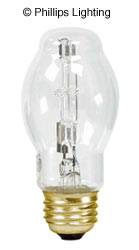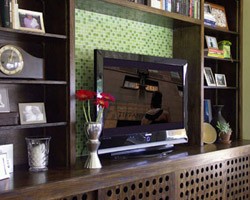At NYIAD we teach our students a simple Three-Step Method for designing every room they create:
- A successful room is functional.
- A successful room expresses a mood.
- A successful room exhibits a sense of harmony.
This simple Three-Step Method is the secret of every interior ever designed. We teach our interior design students to consider these three steps every time they look at a room. You'll find the great home decorating ideas in our Room of the Month series as well as in the design tips on this site helpful in creating outstanding room designs.
When our students mail in their interior design project for analysis by their instructor, the instructor starts by commenting on these three Guidelines. Of course, the instructor analyzes other elements of the project too – decor, layout, furniture, style etc. But the key to good decor – and the essential element of every great interior design – is adherence to these three NYIAD Guidelines.
How do they work? How can you apply them? It's beyond the scope of this Web site to teach you every nuance, but you will get an inkling from the Room of the Month Analysis that follows.
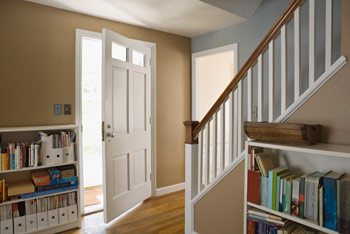
As part of our focus on clutter clearing this month, we've chosen this front hall for our Room of the Month, because it creates such a pleasant welcome, and yet it's realistic.
We always look at function, mood, and harmony in analyzing a room—these are the NYIAD Guidelines to Interior Design, and they work beautifully as a way to consider how a room is working.
This hallway doesn't have much of a mood to it, unless that mood is functional. And in terms of harmony, the harmony mostly comes simply from the repeated pattern of books on the shelves. But here, that's okay, as the more important question is whether a front hall functions well.
This is an especially important consideration in a front hall because any entrance to a home (or office, or hospital, or hotel) must serve several different purposes.
First, the entrance to a home sets the tone of the home to a visitor or to the occupants. Come into a home with a disordered entrance, and you immediately feel disordered yourself. Come into a nicely organized hall, with a vase of fresh flowers and a pretty chair, and you feel happy and calm.
The main function of the entrance is that it's usually the home's collection and transfer station. Everything that comes into the home stops off here and sits for awhile — your keys, the kids' knapsacks, the newspaper and mail, the dog's leash, the shopping bags, the coats and scarves and mittens and hats. If you have children, they'll add any number of other odd items, from rollerblades to stray cats to friends.
How can you possibly organize all this?
The biggest mistake people make in trying to impose order on a front hall is by trying to go in a direction opposite to the one where your nature leads you. You decide that from now on, you'll hang onto your keys and purse until you get to the kitchen, or you insist that no longer can the mail be dropped on the hall table, but must be immediately sorted.
The reason this approach doesn't work is because it doesn't acknowledge the reality of how you're living.
Instead, accept it that the entrance is the transfer station. If that's the case, you need a system right there, by the door.
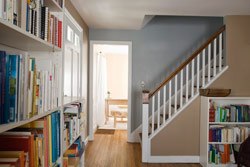
You can start by noticing exactly what it is that collects at the front door, and then creating the right container for it.
In this front hall, you can see a pretty wooden bowl sitting on the top of the lower bookcase. This bowl can hold keys, spare change, and any other small items that want to be dropped immediately.
The mail immediately goes into the folders that are stacked on the larger bookshelf.
One important thing missing from this hall is the view of the closet, but it's safe to assume that the closet is being used well by this family, because we don't see coats draped over the banister, or a collection of mittens and scarves on top of the smaller bookcase.
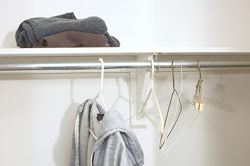
One of the best ways to start organizing the front hall is by first cleaning out the front hall closet. If the closet is jammed with old sweaters and boxes you keep meaning to take to the recycling, you won't want to cram your jacket in there—and instead, it will land on the banister. And your ten-year-old's jacket will land on the floor.
Granted, your closet won't look as bare as this one, but it'll be much more appealing. You may even have room to add a shoe rack or a hook for scarves and bags.
This entrance may not look glamorous, but it works in terms of its function—and that works well in terms of its design.


